

SVU’s draft proposal for a
UK Ring Main
In response to National Grid's proposals to further blight our beautiful landscape with yet more pylons, Stour Valley Underground present a grid enhancement strategy that totally removes the need for any more pylons. This proposal is a strategic road map for Britain that frees the landscape of pylons, fully integrates the UK into the coming Europe wide renewable energy distribution grid, fully serves the green agenda and massively improves UK national energy security and economic prospects.
Please note that this is a draft proposal, currently out for consultation and will be amended in light of that consultation. Copyright SVU 2010
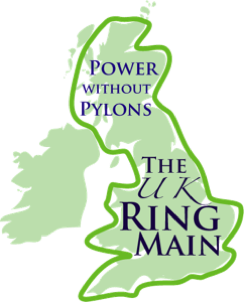
Preamble
Stour Valley Underground (SVU), in consultation with experts in many related fields has, since its founding, strived to find a unifying strategy for solving the energy distribution problems that National Grid are trying to address through the proposals that underpin the current consultation process. In so doing, SVU has developed and assessed a number of strategies both within and beyond the scope of the current consultation process. A process of developing a strategy, finding it wanting, stepping back and taking a wider view and developing a new strategy has now passed through several iterations. The strategy we present here is the culmination of this process and is the one which we believe fulfills the needs of all campaigning groups who fight to free our beautiful landscape of the blight of electricity transmission pylons. Indeed, we argue that this strategy is a roadmap to a future that fully embraces a carbon free energy generation future, is fully compatible with the coming Europe wide renewable energy distribution grid and at one and the same time, allows the landscape of the Britain to be restored to its natural, pylon free state such that it can act as the enormous asset for the nation that it has the potential to be.
Background
Historically, power generation in the UK has been predominantly done in the north and the power has been transmitted south to where it is used, in great part to the London area. This was because coal was heavily used to power the generators and the coal fields were situated in the north and midlands. In the following map National Grid illustrate the spinal nature of the existing grid bringing the power south.
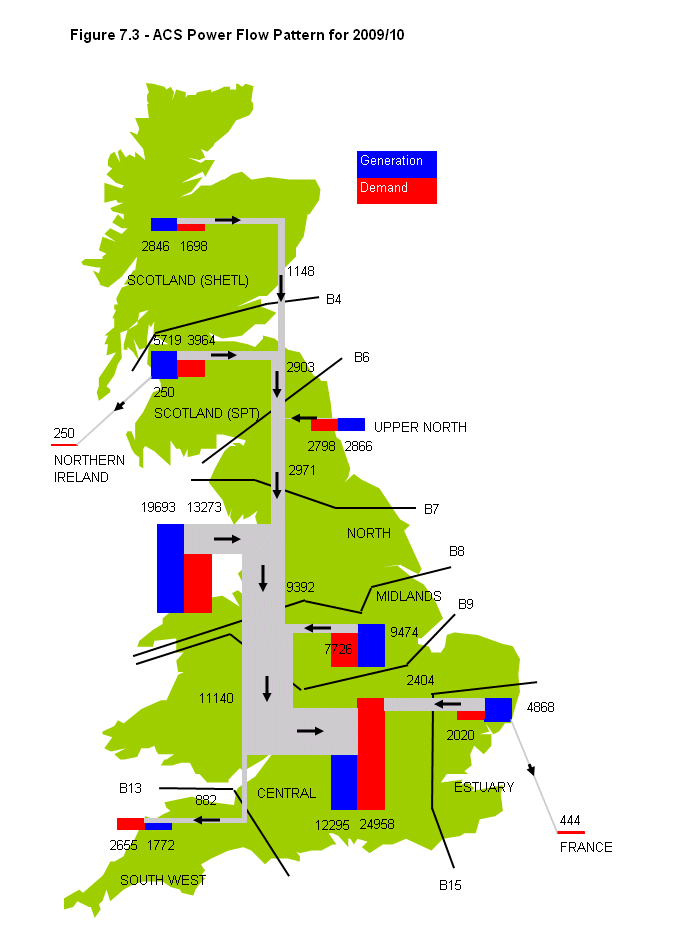
The following Existing Nuclear Power Stations map shows current and decommissioned nuclear generation facilities which are all located around the coast.
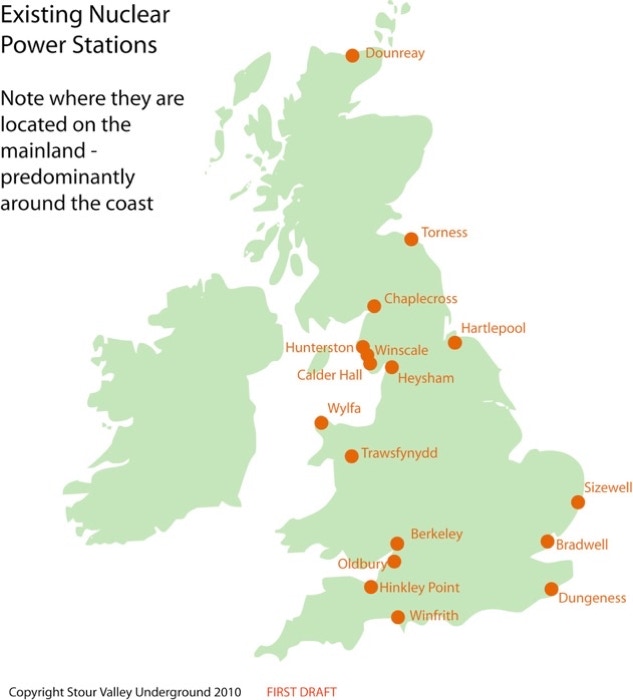
In the future, power generation will be predominantly located around the coast and will take the low carbon forms of wind and nuclear generation with other renewables also contributing.
The Proposed New Nuclear Map (below) shows that all future nuclear power stations will be located on the coast.
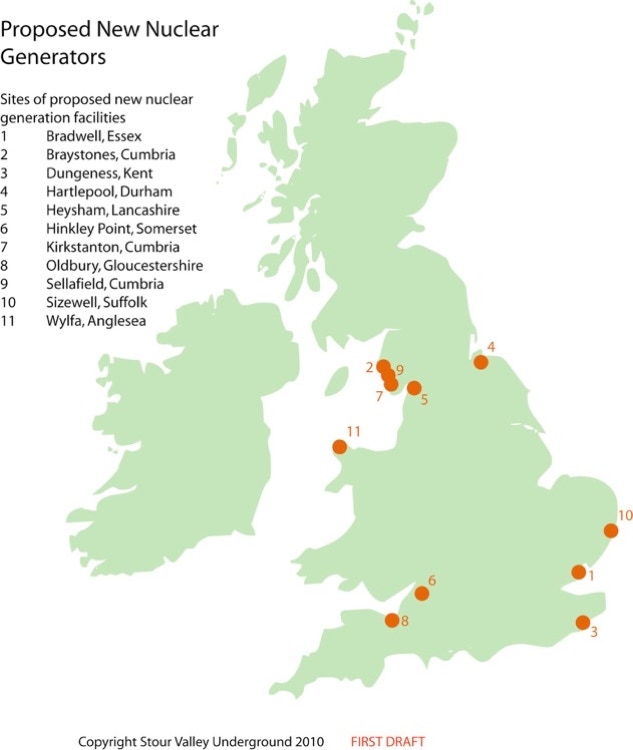
The Currently Proposed Wind Farm map (below) indicates the off shore locations of the proposed sites and also indicates that the HVDC technology we propose to use for the UK Ring Main will be used in any case to bring the power ashore.
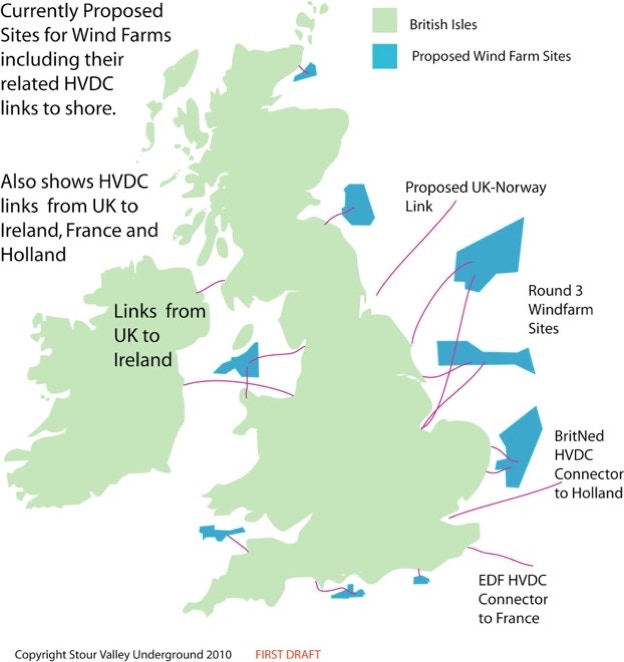
The current pylon strewn distribution grid is not designed for this coastal generation and is also not compatible with the new electricity generation, distribution and usage technology known as Smart Grid. We therefore argue that far from requiring patching up, the existing grid needs replacement with a system in keeping with the coming technologies.
From The Independent newspaper in an article published in July 2009 we learn of Steve Holliday's (the CEO of National Grid(NG))view of the technologies and strategies that underly the proposal we present here and the article stated:-
But rather than simply boosting the existing network, the group (NG) has a more radical scheme to build new links running down each coast under the sea. The plan for the west coast – from Scotland to just south of Liverpool – is the most advanced. It is no more costly than the more conservative upgrade plan. And although there are some challenges – such as shifting the current to DC when it goes offshore, and AC when it comes back on again – none of the technical novelties is a showstopper. "I just don't think anyone ever thought of doing this before," Mr Holliday says. The plan for the eastern half of the plan has yet to be proven. But the western undersea grid is a "no-brainer", Mr Holliday insists, even for a company as risk-averse as National Grid. Ofgem seems to agree. The regulator has made a rare exception to the rules and given National Grid the go-ahead to start work on the project before the business case is fully worked out.
From this we can see that parts of the strategy we propose below are already being worked on and funded by NG/Ofgem. We further observe that these developments are using strategies outside those being considered under the current NG consultation process with respect to the NG projects proposed for Bramford-Twinstead, Hinkley Point and Beuley-Denny. The funding is also coming from special additional revenue generation arrangements beyond and outside Ofgem's normal investment time horizons.
Proposition
We conclude that the solution to the problem of delivering bulk, renewably generated green energy in a reliable, economic and secure way is to develop a ring main for the UK. We propose that all bulk electricity is distributed by undersea cables running undersea around the coast with nodes at strategic points where offshore generation and international power cables link in and also domestic supply cables can lead up the estuaries to bring bulk energy to the population centers in the UK. This cabling should employ High Voltage Direct Current technology(HVDC). We argue that where major population centers are not readily amenable to this solution, that the cables should run in underground tunnels which should also house data cables and that the heat generated within these tunnels should be captured and used productively. On a local level we argue that all distribution cables 132kV and below should be buried. SVU believe that this whole strategy should be seen as a road map leading to a totally pylon free and carbon free electrical energy system by 2040. This means full implementation of smart grid technology including distributed and computer intelligently controlled energy generation, distribution and use. This is also wholly compatible with the developing Europe wide electricity distribution which is currently under development.
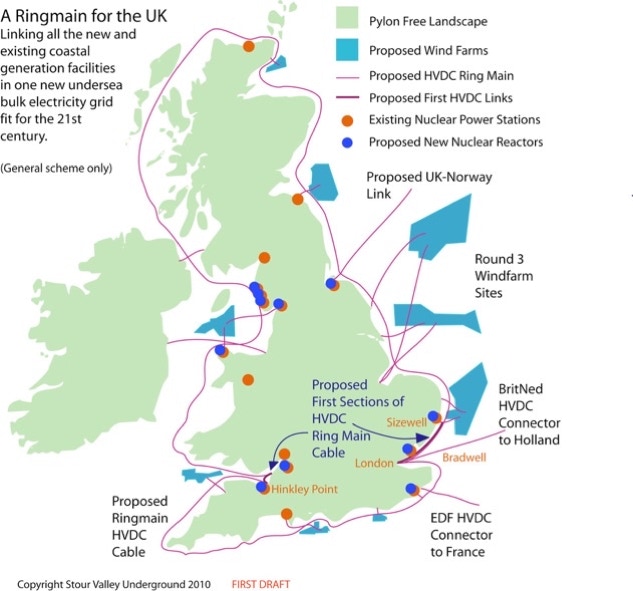
It is worth noting that the UK, being an island is almost uniquely placed to take advantage of HVDC undersea cabling with no point on land being more than 60 miles from a tidal estuary making it ideal for a high voltage power supply grid around the coast.
Rationale
An international super grid is being developed across Europe which will enable energy to be transmitted from where it is generated to where it is used. Because the most efficient technology for this is HVDC, that is the technology being used. Already, an international grid is being developed in and around the North Sea using this technology. Renewable energy generation brings with it the requirement to mitigate the fact that renewable generation from wind farms, solar and hydro electric sources is intermittent. In Norway (for example) they have a dry season when hydroelectric generation produces far less energy.Norway is already linked into the rest of Europe by the NorNed HVDC connector running north-south to mitigate the dry season issue.
The wind does not always blow and also the weather systems move across the continent. To deal with this, wind farms will (for example) be spread right across Europe and as the weather systems move across the continent, so the various wind farms will harvest the energy from the wind and feed it into the new grid which will distribute it to where it is needed.
The various time zones across the continent also impact this issue and effect the peaks and troughs in demand. The Europe wideintelligently controlledgrid will allow all of these influences to be balanced out and together with nuclear generation, allow the whole continent to move to a more carbon free energy economy.
A grid in theNorth Seais already being developed, hitherto in a seemingly peacemeal manner with an HVDC link from Britain to France and the BritNed HVDC link about to be built. But this is to change and in February 2010 an international gathering will seek to develop this strategy in a coordinated fashion. There will also soon be HVDC links from the UK to Scandinavia with more to follow. In the south of the continent and in North Africa there is also enormous potential for solar collection of energy and this will also feed north into the new europe wide grid.
So green energy from renewable sources is or is about to flow north - south and east - west across Europe and our proposal is to extend this strategy to serve the United Kingdom bringing energy to and from the British Isles and also distributing it north - south and indeed all around these islands via high efficiency HVDC cables in one continuous super grid. By this means the United Kingdom can insulate itself from the irregularities of renewable generation, reduce the country's future dependence on nuclear generation whilst at the same time building infrastructure that is far more secure and efficient.
Affordability
National Grid looked at a hybrid HVDC/overland solution to getting the power from Sizewell to London but it was seen only in the context of solving a local problem and in this context was ruled out as prohibitively expensive. This proposition sees the Sizewell - London HVDC link along with the currently proposed Scotland - England HVDC links and also the Hinkley Point link in Somerset as the first steps in developing thisring mainfor the United Kingdom and so the cost has to be seen in this context. We argue that the building up of the ring main should be a step by step process with the initial steps being to provide the grid reinforcements that are currently identified. As the process of implementation moves forward and more offshore generation comes on line, so the generation site to shore HVDC links can be added along with the associatedring mainlinks to integrate this into the whole scheme.
SVU note that potentially, a large proportion of Europe's low carbon generation can come from the UK and the potential for wind farm generation is around 1/3 of the total for the continent. This points to the strong possibility of Britainbecoming a net renewable energy exporter with all the economic and security benefits that flow from that. It is already clear that there is considerable potential for revenue generation through the trading of electricity. This can only happen if the UK is a fully linked in participant in the Europe wide grid.
Conclusion
Stour Valley Underground conclude that the only responsible solution to fulfilling the grid reinforcement needs identified by National Grid in their current Bramford to Twinstead grid reinforcement project is to connect the planned new generation facilities on the East Coast to London by HVDC link running undersea. We see this link as the first step in developing an HVDC ring main to distribute all bulk electricity by 2040. This ring main should comprise HVDC cabling around the entire coast, linking to the European grid, costal generation and major UK population centers. We believe that all local distribution and any cross country bulk transmission should achieved be by underground cable with tunnels employed to carry bulk transmission cables. We argue that this long term strategy is imperative if the UK is to fully benefit from its potential as a renewable energy generator and also in order to deal with the inevitable peaks and troughs in renewable generation along with the well documented and understood peaks and troughs in electricity usage.
For the people of the East of England along with those in the Highlands of Scotland and in Somerset, near Hinkley point, this strategy brings the benefit that no new pylon lines are needed, no further blighting of the landscape and indeed this strategy provides a road map to the removal of all pylons from the landscape such that it can be enjoyed and exploited as the natural and beautiful asset that it could be.
As stated at the top of this article, this proposal is currently in draft form only and is presented as a discussion document which will be developed and amended in light of contributions from interested parties. Stour Valley Underground seek to develop a grid improvement strategy that is in the best interests of all the UK and all campaigners around the country who seek to defend their countryside from the blight of pylons and ensure that a strategy is adopted by National Grid that embraces the coming renewable energy generation and distribution technologies along with the smart grid. If that characterization includes you and you wish to comment on this proposal we would warmly welcome your input. Our contact details are on the Contact page.
Proposal written and researched by Richard Barnes and David Holland for SVU.
